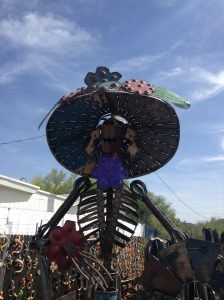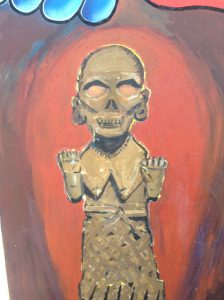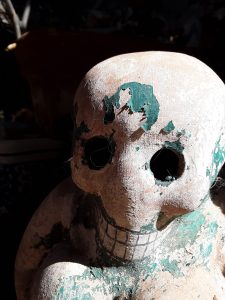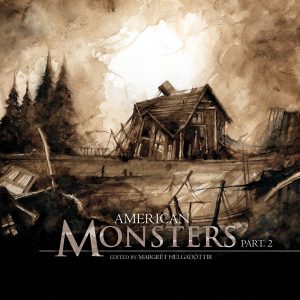American Monsters Part 2 is available now.
AZTLÁN: A NEXUS OF MONSTERS
by Ernest Hogan
Okay, I admit it, I cheated. Instead of picking a North America monster to write about, I wrote about a nexus of monsters. The subject is more of a densely populated Hieronymus Bosch triptych than a portrait of a lone specimen.
The region where I was born and lived all my life is full of all the bizarre creatures, beings, etc. I couldn’t pick just one. The Southwest of the United States of (North) America, also known as the Wild West, the Great American Desert, Aztlán, the Aztec homeland, is a land of monsters from Native beliefs, folklore of Anglo, Hispanic, and other immigrant folklore, tall tales, fiction, and various popular cultures, not to mention the bubbling cauldron of new cultures constantly being created that I call recomboculture. Just thinking about them sends my imagination soaring.
The problem with my imagination is that once it starts soaring, you never know where it will end up . . .
I was a monster kid in my childhood, but not at first. There was a time when they invaded my nightmares, and I did my best to avoid them, even though they were everywhere – TV, movies, comic books. It was a monster culture back then, in the Atomic Age. Then one night I dreamed that one had me cornered; I had no choice but to turn around and face it, throwing punches, and the beast-thing crumbled into black dust that blew away.
After that I couldn’t get enough of monsters. I identified more with them than the heroes who slayed them.

Growing up in California, the farthest edge of the Southwest, brought a lot of monsters into my life. Don’t let the popular image of fun in the sun fool you; just as the air is a cocktail of pollutants, monsters lurk everywhere. The beaches are the border to the icy Pacific Ocean, home to sea monsters, real and imagined. The fossil record tells us that much of the Southwest was once under an ocean populated by sea monsters that rival the tales of mariners.
Later, I met and married, Emily Devenport, author of Medusa Uploaded. Living with her helped me learn about Arizona, and its monster lore. Besides sharing our love of monsters, delivered by books and media, we had many hair-raising conversations that caused us to feel inhuman eyes staring at us from the dark, and we take road trips whenever we can, taking a lot of photos and notes.
You want to know where writers get their crazy ideas?
Unlike California, which is new in the geological sense, Arizona is dinosaur country. There was even once an inland sea with swimming monsters. This is the land of the thunderbird, and even though the pterodactyl-looking photos from the Tombstone Epitath look fake, and are undocumented, they have a funky appeal, and link to the Native myth. Fossilized bones probably inspired many a monster. Recently, Emily and I found a Mexican restaurant where, among the vaquero scenes, was a painting of a dragon.

Some monsters were born here, others are immigrants.
All along the Rio Grande Valley, and beyond, La Llorona, the crying woman, whose origins can be traced to Aztec beliefs about the afterlife of women who died in childbirth – night-walking disease spirits. She is also related to the fancy-dressed, decorated sugar skull-faced Catrinas, a caricature of the middle class that has become a symbol of Latin womanhood and the Day of the Dead.
Also in the night is el Cucuy, the Mexican boogie man, eager to carry away children who wander after dark.
El Cucuy and La Llorona, because of decades of not being on the radar of mass media, have undergone interesting manifestations. In Phoenix, La Llorona is called Mano Loco, and dwells in canals and swimming pools instead of her usual rivers. My mother tells me that in riverless East Los Angeles, she was said to live in a row of trees in a nearby park.
This pre-internet folklore in isolation made the monsters personal, inspiring one of my cousins’ description of El Cucuy:
“He’s eyes – lots of eyes, all over his face. And legs – lots and lots of legs. He grabs you with these legs and takes you away . . .”
Hoodoos are eerie rock formations that seem to be alive, like the saguaro cactus that often has two arms, like a person. Some say that both were originally people, who were transformed by curses

cast by practitioners of witchcraft, both Native and brought over from Spain. I used to doubt Carlos Casteneda because the witchcraft he describes in his books can be found illustrated in Goya’s Los Caprichos etchings, but now I know that witches, as well as conquistadors, colonized Aztlán.
All the supernatural beings probably have not been as thoroughly catalogued as the Mogollon monster and other Sasquash/Yeti manifestations.
Native witches and sorcerers can become the local version of the werewolf – the skinwalker. Not long ago they were a taboo subject, but recently I bought a DVD of a documentary about them in a motel lobby, and had a Navajo taco at a restaurant where the waitress wore a t-shirt with a glyph known as The Wolfman. The monsters are going pro.
Fireballs streaking across the sky have been said to be sorcerers, flying long before the modern world created its own myths of flying saucers from outer space.
It all collides with the science fiction folklore of the modern world.
A lot the old monster movies were filmed here. The backdrop that Hollywood used for westerns also works as a home for monsters.
Like in my story “Cuca” the global, electronic world of corporate entertainment is colliding with the folklore. The issue of who owns these creatures – if indeed they can be owned – will arise.
There is a difference between the motivations of the entertainment industry and the cultures that create folklore. They may be able to coexist, but the monsters can never really be tamed. New fictions, and new realities – and new monsters – will be created. And it won’t be boring.
Makes me glad to live here.

